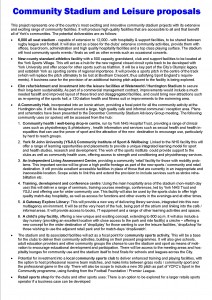We understand that the planning application for the new community stadium development at Monks Cross will not now be considered before February. There are some refinements to the original layout with the original plan – to house most of the community facilities within the stadium – being resurrected. The autumn plan had included a separate community block nearer the car park.
The design for the new stores will include large screen displays which will be used by Visit York – the tourism agency – to encourage visitors to sample the delights of the City Centre during their time in the City.
We understand that representations are being made by some traders direct to government Ministers asking for the scheme to be subject to “called in”. If the planning application is approved by local Councillors it would have – by law – to be referred to the Local Government Minister anyway simply because part of the site (the Huntington Stadium) is owned by the Council.
However it is for the Minister to decide whether to hold a Public Inquiry. Opponents of the scheme know that such an Inquiry would take months to organise. They hope that the scheme – or the football club -would flounder in the meantime.
Something similar happened in 2005 when opponents of a new Barbican swimming pool took legal action to prevent a start on constructing the replacement pool at Kent Street. They didn’t win their case, but the delay resulted in the developer money going elsewhere in the country.
Now the fear is that the anchor occupiers for the enabling development – John Lewis – will concentrate their expansion at the new £600 million development which is taking shape at “Eastgate Quarters” in Leeds.
Separately the Council will discuss on Tuesday how they see any new stadium being managed. The proposal is likely to involve the use of a “not for profit” social enterprise company of the sort that already runs the existing Huntingdon stadium and adjacent fitness facilities (both of which would be modernised under the plans).
The Council now expect to go further and put other leisure facilities such as “Energise” in Acomb and the Yearsley pool under the same management umbrella.
The report gives further details of the community facilities that it is hoped to provide (see list above right).
Rather alarmingly there is still no draft business plan included in the report showing the main income/expenditure heads for the stadium operation while the following description does raise concerns about whether costs are really under control “(provide a) Community Hub, incorporated into an iconic atrium, providing a focal point for all the community activity at the Huntington site. It will be designed around a large, high quality café and informal communal / reception area”.
Nevertheless a Trust type model for stadium management is probably the best way forward and should go some way to reassuring those who question the viability of the project.

